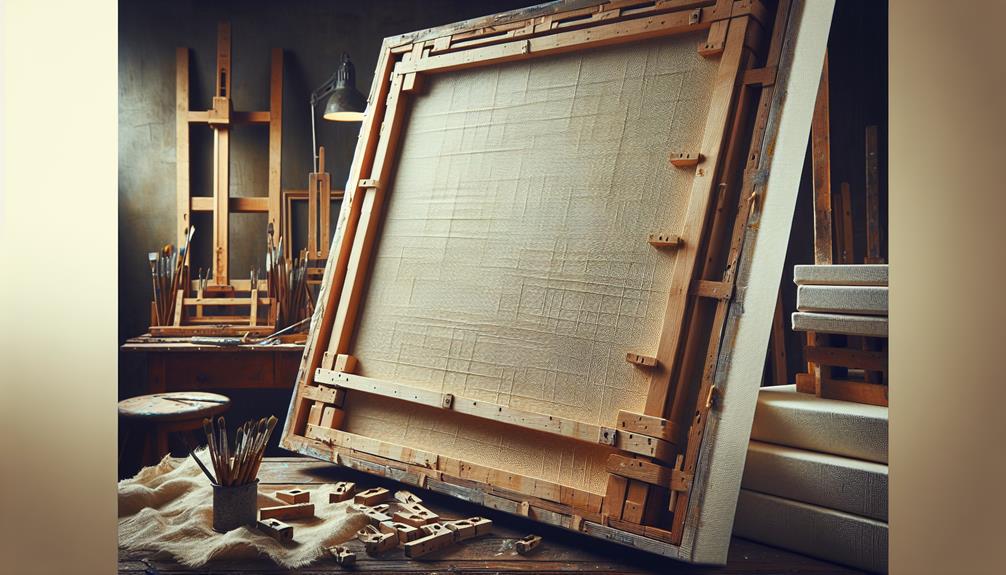
What Is a Painting Canvas
Share
The concept of a painting canvas may seem straightforward, but its role in the art world is far from simple. Beyond being a mere surface for artists to apply their brushstrokes, the canvas has a rich history and a range of characteristics that can significantly impact the outcome of a painting.
From the materials used to its preparation and texture, the canvas holds a myriad of possibilities for artistic expression. Understanding the nuances of this seemingly basic component can shed light on the complexities and subtleties of the art it helps bring to life.
Key Takeaways
- Canvas has been used for painting since the Italian Renaissance in the 16th century.
- Cotton canvas is popular for its affordability and smooth surface, while linen canvas is favored for its durability.
- The choice of canvas depends on factors such as fabric type, texture, and weight.
- Priming the canvas is crucial for successful painting, and different techniques can be used depending on the desired effect.
History of Painting Canvases
The history of painting canvases encompasses the evolution of canvas as a popular and enduring medium for artists, particularly gaining prominence during the Italian Renaissance in the 16th century. Canvas, typically made from cotton, linen, or hemp, has been utilized as a painting surface since the 14th century due to its durability and lightweight nature. Stretched canvases, wooden panels, and fabric are common forms of canvas used for painting. Primed cotton canvas is a preferred choice among artists due to its smooth surface and ability to hold acrylic and oil paints effectively.
During the Italian Renaissance, canvas offered artists a portable and versatile medium for their artistic expression. The advent of oil and acrylic paints further solidified canvas as a preferred surface due to its ability to withstand the weight and texture of these paints. Acrylic paint, in particular, gained popularity due to its quick drying time and ease of use, making it a preferred choice for beginners.
The history of painting canvases reflects the enduring appeal of this medium and its continued relevance in the contemporary artistic landscape.
Types of Painting Canvases
In tracing the evolution of painting canvases, it is essential to analyze the various types and characteristics of canvases utilized by artists throughout history.
Canvas, the most common support for painting, comes in various types such as plain weave, canvas fabric, and canvas rolls.
When it comes to painting on canvas, artists often choose between acrylic painting and oil painting.
Primed canvas, which has been coated with a primer to create a smooth painting surface, is widely used by artists due to its convenience.
The two primary types of painting canvases are cotton and linen.
Cotton canvas is popular due to its affordability and smooth surface, making it suitable for beginners and practice pieces.
On the other hand, linen canvas is favored for its durability, strength, and ability to withstand the aging process better than cotton.
Canvas paintings are often created using stretched canvases, where the canvas is stretched and secured to a wooden frame.
Additionally, artists may opt for canvas panels, which are canvas sheets mounted onto a rigid board, providing a stable surface for painting.
Understanding the characteristics and differences among these types of canvas is essential for artists to make informed choices based on their artistic preferences and the specific requirements of their projects.
Choosing the Right Canvas
When selecting a canvas for painting, artists should carefully consider factors such as fabric type, texture, weight, and priming to ensure compatibility with their preferred painting style and techniques. It's essential to choose the right surface for the intended artwork.
Here are some considerations to keep in mind when choosing the right canvas:
- Fabric Type and Texture
- Finely woven canvas is recommended for smaller, detailed work, while rougher weave is ideal for broad brush strokes and larger paintings.
- Weight and Priming
- The density of the thread determines the weight and quality of the canvas, with cotton canvas ideally weighing between 12-15 ounces.
Considering alternatives to stretched canvas:
- Canvas Panels
- Offer a more affordable alternative to stretched canvas.
- Canvas Pads
- Convenient for beginners and students.
Furthermore, the choice between acrylic or oil paints also influences the selection of the canvas. Acrylic paints are easy to work with and dry quickly on canvas, while oil paints are ideal for canvas due to their thick texture.
Painting on Canvas Techniques
Mastering the techniques for painting on canvas requires a thorough understanding of the materials, tools, and application methods specific to each medium, ensuring the successful execution of artistic vision and expression.
When working with oil paint on canvas, artists often prefer using a stretched canvas mounted on a wooden frame. Techniques for oil painting on canvas involve the use of round-tipped or synthetic bristle brushes to apply the paint in layers, allowing for blending and creating texture.
On the other hand, when using acrylic paint on canvas, artists commonly basecoat the canvas with acrylic gesso, enabling them to layer the paint for rich color effects. Choosing the right canvas is crucial, considering factors such as the fabric, texture, weight, and priming. Finely woven canvases are recommended for detailed work, while a rougher weave may be preferred for broader brush strokes.
Additionally, the preparation of the canvas for painting involves priming, which can be done with traditional gesso, alternative primers, or leaving it unprimed. These techniques and considerations contribute to the successful creation of paintings on canvas, whether using oil or acrylic paints.
Tips for Painting on Canvas
The successful execution of artistic vision and expression when painting on canvas depends greatly on employing effective techniques and following essential tips for achieving optimal results. To ensure the best outcomes when painting on canvas, consider the following tips:
- Select High-Quality Canvas Materials:
- Utilize durable materials such as linen or cotton for the painting surface, as they provide a premium and long-lasting base for artwork.
- Ensure the canvas is stretched properly over a wooden frame to prevent sagging or warping over time.
- Choose the Right Paint and Techniques:
- Use acrylic or oil paints for canvas painting, as they adhere well to the surface and offer vibrant colors and textures.
- Experiment with different brush strokes and techniques to achieve desired effects, such as blending, layering, or impasto.
Frequently Asked Questions
What Is a Canvas in Painting?
Canvas in painting encompasses various types, textures, and sizes, suited for different artistic applications. Preparation involves stretching and priming the canvas to ensure a smooth, durable surface. Care and historical significance play vital roles in choosing canvas alternatives.
What Are Canvases for Painting Made Of?
Canvas materials used for painting include cotton, linen, and hemp, offering diverse textures and color blending options. Artists employ various painting techniques on canvases, expressing their creativity and contributing to the historical significance of this versatile medium. Proper canvas preparation and framing options are essential for artistic expression.
Is Canvas Painting Expensive?
Canvas painting cost varies based on size, material quality, and paint. While initial investment may seem high, the artistic value and durability make it a worthwhile investment. Canvas prints offer creative and budget-friendly alternatives, reflecting market trends.
Are All Paintings Done on Canvas?
While canvas is a popular choice, paintings can be executed on various surfaces such as paper, wood panels, metal, and textiles. Different mediums like digital, acrylic, watercolor, and oil offer diverse options for artistic expression beyond canvas.
Conclusion
In conclusion, the painting canvas has a rich history and offers artists a versatile and lightweight surface for artistic expression.
With a variety of canvas types and textures to choose from, artists can achieve different effects and styles in their paintings.
By employing various painting techniques and selecting the right canvas, artists can create visually stunning and expressive works of art that captivate and inspire viewers.




